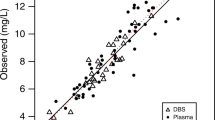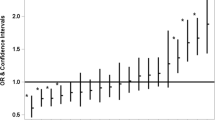Abstract
Objective:
To examine the impact of a change in the empiric gentamicin dose from 5 mg kg−1 every 24 h (Q24 h period) to 5 mg kg every 36 h (Q36 h period) on target drug concentration achievement in neonates with hypoxic ischemic encephalopathy (HIE) receiving therapeutic hypothermia.
Study Design:
Gentamicin drug concentrations in neonates with HIE receiving therapeutic hypothermia were examined during two time periods in a retrospective chart review. During the initial treatment period (November 2007 to March 2010; n=29), neonates received Q24 h period. During the second treatment period (January 2011 to May 2012; n=23), the dose was changed to Q36 h period. Cooling criteria and protocol remained the same between treatment periods. Gentamicin drug concentrations including achievement of target trough concentrations (<2 mg l−1) were compared between treatment periods. Individual Bayesian estimates of gentamicin clearance were also compared.
Result:
Neonates with an elevated trough concentration >2 mg l−1 decreased from 38 to 4% with implementation of a Q36-h dosing interval (P<0.007). The mean gentamicin trough concentration was 2.0±0.8 mg l−1 during the Q24 h period and 0.9±0.4 mg l−1 during the Q36 h period (P<0.001). Peak concentrations were minimally impacted (Q24 h 11.4±2.3 mg l−1 vs Q36 h 10.0±1.9 mg l−1; P=0.05). The change in gentamicin trough concentration could not be accounted for by differences in gentamicin clearance between treatment periods (P=0.9).
Conclusion:
A 5 mg kg−1 every 36-h gentamicin dosing strategy in neonates with HIE receiving therapeutic hypothermia improved achievement of target trough concentration <2 mg l−1, while still providing high peak concentration exposure.
This is a preview of subscription content, access via your institution
Access options
Subscribe to this journal
Receive 12 print issues and online access
$259.00 per year
only $21.58 per issue
Buy this article
- Purchase on Springer Link
- Instant access to full article PDF
Prices may be subject to local taxes which are calculated during checkout


Similar content being viewed by others
References
Azzopardi DV, Strohm B, Edwards AD, Dyet L, Halliday HL, Juszczak E et al. Moderate hypothermia to treat perinatal asphyxial encephalopathy. N Engl J Med 2009; 361 (14): 1349–1358.
Gluckman PD, Wyatt JS, Azzopardi D, Ballard R, Edwards AD, Ferriero DM et al. Selective head cooling with mild systemic hypothermia after neonatal encephalopathy: multicentre randomised trial. Lancet 2005; 365 (9460): 663–670.
Róka A, Vásárhelyi B, Bodrogi E, Machay T, Szabó M . Changes in laboratory parameters indicating cell necrosis and organ dysfunction in asphyxiated neonates on moderate systemic hypothermia. Acta Paediatr 2007; 96 (8): 1118–1121.
Shah P, Riphagen S, Beyene J, Perlman M . Multiorgan dysfunction in infants with post-asphyxial hypoxic–ischaemic encephalopathy. Arch Dis Child Fetal Neonatal Ed 2004; 89 (2): F152–F155.
Tarcan A, Tiker F, Güvenir H, Gürakan B . Hepatic involvement in perinatal asphyxia. J Matern Fetal Neonatal Med 2007; 20 (5): 407–410.
Perlman JM, Wyllie J, Kattwinkel J, Atkins DL, Chameides L, Goldsmith JP et al. Part 11: Neonatal resuscitation: 2010 International Consensus on Cardiopulmonary Resuscitation and Emergency Cardiovascular Care Science With Treatment Recommendations. Circulation 2010; 122 (16 Suppl 2): S516–S538.
Zanelli S, Buck M, Fairchild K . Physiologic and pharmacologic considerations for hypothermia therapy in neonates. J Perinatol 2011; 31 (6): 377–386.
Liu X, Borooah M, Stone J, Chakkarapani E, Thoresen M . Serum gentamicin concentrations in encephalopathic infants are not affected by therapeutic hypothermia. Pediatrics 2009; 124 (1): 310–315.
Frymoyer A, Meng L, Bonifacio SL, Verotta D, Guglielmo BJ . Gentamicin pharmacokinetics and dosing in neonates with hypoxic ischemic encephalopathy receiving hypothermia. Pharmacotherapy, advance online publication, 1 April 2013 (e-pub ahead of print).
Bonifacio SL, Glass HC, Vanderpluym J, Agrawal AT, Xu D, Barkovich AJ et al. Perinatal events and early magnetic resonance imaging in therapeutic hypothermia. J Pediatr 2011; 158 (3): 360–365.
Anderson BJ, Holford NHG . . Mechanism-based concepts of size and maturity in pharmacokinetics. Annu Rev Pharmacol Toxicol 2008; 48: 303–332.
Shah PS . Hypothermia: a systematic review and meta-analysis of clinical trials. Semin Fetal Neonatal Med 2010; 15 (5): 238–246.
Glass HC, Bonifacio SL, Peloquin S, Shimotake T, Sehring S, Sun Y et al. Neurocritical care for neonates. Neurocrit Care 2010; 12 (3): 421–429.
Clark RH, Bloom BT, Spitzer AR, Gerstmann DR . Reported medication use in the neonatal intensive care unit: data from a large national data set. Pediatrics 2006; 117 (6): 1979–1987.
Rao SC, Srinivasjois R, Hagan R, Ahmed M . One dose per day compared to multiple doses per day of gentamicin for treatment of suspected or proven sepsis in neonates. Cochrane Database Syst Rev 2011; 11, CD005091.
Lacy MK, Nicolau DP, Nightingale CH, Quintiliani R . The pharmacodynamics of aminoglycosides. Clin Infect Dis 1998; 27 (1): 23–27.
Gentamicin injection USP (package insert). APP Pharmaceuticals LLC: Schaumberg, IL, USA, 2008.
Thomson AH, Way S, Bryson SM, McGovern EM, Kelman AW, Whiting B . Population pharmacokinetics of gentamicin in neonates. Dev Pharmacol Ther 1988; 11 (3): 173–179.
Weber W, Kewitz G, Rost KL, Looby M, Nitz M, Harnisch L . Population kinetics of gentamicin in neonates. Eur J Clin Pharmacol 1993; 44 (Suppl 1): S23–S25.
García B, Barcia E, Pérez F, Molina IT . Population pharmacokinetics of gentamicin in premature newborns. J Antimicrob Chemother 2006; 58 (2): 372–379.
Nielsen EI, Sandström M, Honoré PH, Ewald U, Friberg LE . Developmental pharmacokinetics of gentamicin in preterm and term neonates: population modelling of a prospective study. Clin Pharmacokinet 2009; 48 (4): 253–263.
Sarafidis K, Tsepkentzi E, Agakidou E, Diamanti E, Taparkou A, Soubasi V et al. Serum and urine acute kidney injury biomarkers in asphyxiated neonates. Pediatr Nephrol 2012; 27 (9): 1575–1582.
Askenazi DJ, Ambalavanan N, Goldstein SL . Acute kidney injury in critically ill newborns: What do we know? What do we need to learn? Pediatr. Nephrology 2009; 24 (2): 265–274.
Askenazi DJ, Griffin R, McGwin G, Carlo W, Ambalavanan N . Acute kidney injury is independently associated with mortality in very low birthweight infants: a matched case–control analysis. Pediatr Nephrol 2009; 24 (5): 991–997.
Krawczeski CD, Woo JG, Wang Y, Bennett MR, Ma Q, Devarajan P . Neutrophil gelatinase-associated lipocalin concentrations predict development of acute kidney injury in neonates and children after cardiopulmonary bypass. J Pediatr 2011; 158 (6): 1009–1015.
Askenazi DJ, Montesanti A, Hunley H, Koralkar R, Pawar P, Shuaib F et al. Urine biomarkers predict acute kidney injury and mortality in very low birth weight infants. J Pediatr 2011; 159 (6): 907–912 e1.
Koren G, Barker C, Bohn D, Kent G, Biggar WD . Influence of hypothermia on the pharmacokinetics of gentamicin and theophylline in piglets. Crit Care Med 1985; 13 (10): 844–847.
Satas S, Hoem NO, Melby K, Porter H, Lindgren CG, Whitelaw A et al. Influence of mild hypothermia after hypoxia–ischemia on the pharmacokinetics of gentamicin in newborn pigs. Biol Neonate 2000; 77 (1): 50–57.
Shellhaas RA, Ng CM, Dillon CH, Barks JDE, Bhatt-Mehta V . Population pharmacokinetics of phenobarbital in infants with neonatal encephalopathy treated with therapeutic hypothermia. Pediatr Crit Care Med 2012; 14 (2): 194–202.
Van den Broek MPH, Groenendaal F, Toet MC, Van Straaten HLM, Van Hasselt JGC, Huitema ADR et al. Pharmacokinetics and clinical efficacy of phenobarbital in asphyxiated newborns treated with hypothermia: a thermopharmacological approach. Clin Pharmacokinet 2012; 51 (10): 671–679.
Gal P, Toback J, Erkan NV, Boer HR . The influence of asphyxia on phenobarbital dosing requirements in neonates. Dev Pharmacol Ther 1984; 7 (3): 145–152.
Rastogi A, Agarwal G, Pyati S, Pildes RS . Comparison of two gentamicin dosing schedules in very low birth weight infants. Pediatr Infect Dis J 2002; 21 (3): 234–240.
Touw DJ, Westerman EM, Sprij AJ . Therapeutic drug monitoring of aminoglycosides in neonates. Clin Pharmacokinet 2009; 48 (2): 71–88.
Acknowledgements
We thank Susan Peloquin, RN, MS, Clinical Coordinator of the UCSF Neuro-Intensive Care Nursery and members of the UCSF Neuro-Intensive Care Nursery leadership and nursing teams for helping support this project. AF received support, in part, by the National Institutes of Health Grant R01 AI50587. DV received support, in part, by National Institutes of Health Grant R01 AI50587, GM26696. SLB received support by the National Center for Advancing Translational Sciences and National Institutes of Health through UCSF-CTSI Grant KL2TR000143.
Author contributions
AF wrote the first draft of the manuscript and NO honorarium, grant or other form of payment was given to anyone to produce the manuscript. Each author listed on the manuscript has seen and approved the submission of this version of the manuscript and takes full responsibility for the manuscript. Each author clearly meets authorship criteria as described at http://www.icmje.org.
Author information
Authors and Affiliations
Corresponding author
Ethics declarations
Competing interests
The authors declare no conflict of interest.
Additional information
Previously presented: (1) data from the Q24 h period were used for a published population pharmacokinetic analysis and formed the basis for the every 36-h gentamicin dose change under study; (2) Preliminary findings of this work, in part, will be presented as abstract and poster for the Pediatric Academic Societies Annual Meeting, Washington, DC, 4–7 May 2013.
Rights and permissions
About this article
Cite this article
Frymoyer, A., Lee, S., Bonifacio, S. et al. Every 36-h gentamicin dosing in neonates with hypoxic–ischemic encephalopathy receiving hypothermia. J Perinatol 33, 778–782 (2013). https://doi.org/10.1038/jp.2013.59
Received:
Revised:
Accepted:
Published:
Issue Date:
DOI: https://doi.org/10.1038/jp.2013.59
Keywords
This article is cited by
-
Pharmacometric approach to assist dosage regimen design in neonates undergoing therapeutic hypothermia
Pediatric Research (2022)
-
Factors impacting unbound vancomycin concentrations in neonates and young infants
European Journal of Clinical Microbiology & Infectious Diseases (2018)
-
High-dose erythropoietin population pharmacokinetics in neonates with hypoxic–ischemic encephalopathy receiving hypothermia
Pediatric Research (2017)
-
Pharmacokinetics of Gentamicin in Newborns with Moderate-to-Severe Hypoxic-Ischemic Encephalopathy Undergoing Therapeutic Hypothermia
The Indian Journal of Pediatrics (2015)



